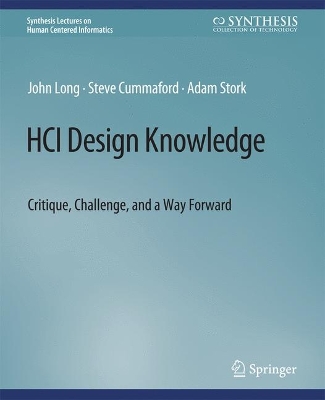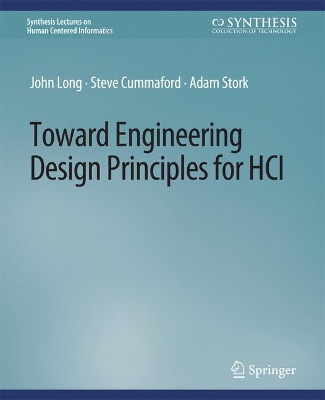Synthesis Lectures on Human-Centered Informatics
2 total works
This is the first of two books concerned with engineering design principles for Human-Computer Interaction-Engineering Design Principles (HCI-EDPs). The book presents the background for the companion volume. The background is divided into three parts and comprises—"HCI for EDPs," "HCI Design Knowledge for EDPs," and "HCI-EDPs—A Way Forward for HCI Design Knowledge." The companion volume reports in full the acquisition of initial HCI-EDPs in the domains of domestic energy planning and control and business-to-consumer electronic commerce (Long, Cummaford, and Stork, 2022, in press). The background includes the disciplinary basis for HCI-EDPs, a critique of, and the challenge for, HCI design knowledge in general. The latter is categorised into three types for the purposes in hand. These are craft artefacts and design practice experience, models and methods, and principles, rules, and heuristics. HCI-EDPs attempt to meet the challenge for HCI design knowledge by increasing the reliabilityof its fitness-for-purpose to support HCI design practice. The book proposes "instance-first/class-first" approaches to the acquisition of HCI-EDPs. The approaches are instantiated in two case studies, summarised here and reported in full in the companion volume. The book is for undergraduate students trying to understand the different kinds of HCI design knowledge, their varied and associated claims, and their potential for application to design practice now and in the future. The book also provides grounding for young researchers seeking to develop further HCI-EDPs in their own work.
Toward Engineering Design Principles for HCI
by Long John, Cummaford Steve, and Stork Adam
Published 25 March 2022
This is the second of two books by the authors about engineering design principles for human-computer interaction (HCI-EDPs). The books report research that takes an HCI engineering discipline approach to acquiring initial such principles. Together, they identify best-practice HCI design knowledge for acquiring HCI-EDPs. This book specifically reports two case studies of the acquisition of initial such principles in the domains of domestic energy planning and control and business-to-consumer electronic commerce. The book begins by summarising the earlier volume, sufficient for readers to understand the case studies reported in full here. The themes, concepts, and ideas developed in both books concern HCI design knowledge, a critique thereof, and the related challenge. The latter is expressed as the need for HCI design knowledge to increase its fitness-for-purpose to support HCI design practice more effectively. HCI-EDPs are proposed here as one response to that challenge, and the bookpresents case studies of the acquisition of initial HCI-EDPs, including an introduction; two development cycles; and presentation and assessment for each. Carry forward of the HCI-EDP progress is also identified. The book adopts a discipline approach framework for HCI and an HCI engineering discipline framework for HCI-EDPs. These approaches afford design knowledge that supports “specify then implement” design practices. Acquisition of the initial EDPs apply current best-practice design knowledge in the form of “specify, implement, test, and iterate” design practices. This can be used similarly to acquire new HCI-EDPs. Strategies for developing HCI-EDPs are proposed together with conceptions of human-computer systems, required for conceptualisation and operationalisation of their associated design problems and design solutions. This book is primarily for postgraduate students and young researchers wishing to develop further the idea of HCI-EDPs and other more reliable HCI design knowledge. It is structured to support both the understanding and the operationalisation of HCI-EDPs, as required for their acquisition, their long-term potential contribution to HCI design knowledge, and their ultimate application to design practice.

